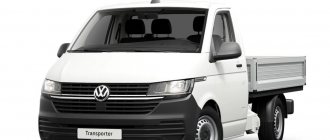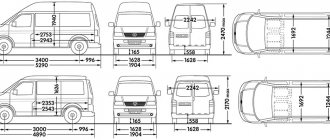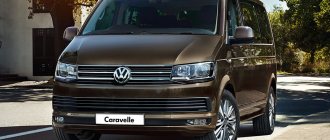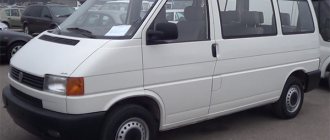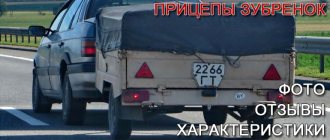Specifications
By the nature of its operation, despite the overall dimensions of the Volkswagen Transporter T4, it is a passenger car: maneuverable, compact and lightweight. Along with this, the VW T4 is equipped with a chassis with a high margin of safety and excellent maintainability. The dimensions of the Volkswagen Transporter T4 depend on the body type, which is usually divided into three types:
- Passenger - up to 9 seats.
- Cargo-passenger - 3-5 seats.
- Cargo - 3 places.
The curb weight of the vehicle is 1580 kg. The permissible loading weight must not exceed 2580 kg. For the Volkswagen Transporter, body dimensions vary over a wide range, which determines the body type:
- width: large - 1840 mm, reduced - 1620 mm;
- length: standard - 5107 mm, reduced - 4789 mm;
- height: standard - 1900 mm, reduced - 1350 mm, increased - 1940 mm.
As already mentioned, VW models are highly resistant to corrosion. This is achieved thanks to the technology of aging steel after stamping, galvanizing parts and using mixtures to increase the adhesion of the paint and varnish coating to the metal surface.
Technical characteristics of Volkswagen Transporter T4
contents
Model VW Transporter T4 is a modern unit with a full set of new developments. It was produced from 1990 to 2003. Technical characteristics of the Volkswagen Transporter T4 have undergone changes in all respects over the course of 13 years of production. The car is represented by the largest number of models, varying in:
- engine power and fuel type;
- configurations;
- purpose.
This model range was discontinued 15 years ago, but despite this, you can find cars with 25 years of service in excellent condition. In addition to the owner’s good care of his equipment, this is due to the excellent corrosion protection of the body. This is especially noticeable in the example if we consider which is better: Volkswagen Transporter or Ford Transit. The latter, which is not inferior in its parameters to VW, has 2 drawbacks: rapid corrosion of the body and poor supply of spare parts. And only thanks to constructive continuity, VW models are free of all these shortcomings, despite the fact that they have been out of production for 15 years.
Another pleasant bonus will be the opportunity to find out that the cars produced by the concern in the period 1990-2000 have a high margin of safety, and many buyers prefer the 4th generation model when choosing.
Volkswagen Transporter T4
Gasoline or diesel
If, when purchasing a Volkswagen Transporter, the problem arises of choosing between a car with a diesel or gasoline engine, you should take into account that the fundamental difference between a diesel engine and a gasoline engine is the method of ignition of the combustible mixture. If in a gasoline engine a spark created by a spark plug ignites fuel vapors mixed with air, then in a diesel engine spontaneous combustion occurs under the influence of compressed air heated to a high temperature.
Diesel and gasoline engines have their advantages and disadvantages
It is generally accepted that a diesel engine is more durable, but cars with such engines are usually more expensive than gasoline versions, all other things being equal. At the same time, among the advantages of diesel, the following should be mentioned:
- its efficiency - fuel consumption is usually 10–15% lower than in gasoline engines;
- higher reliability due to the absence of an ignition system;
- environmental friendliness - the level of CO2 emissions is lower than in gasoline engines.
Diesel, as a rule, has more traction, but is also noisier. Among its disadvantages:
- increased “sensitivity” to low-quality fuel - repairs in this case can be quite expensive;
- more expensive maintenance;
- problems with starting in frosty weather.
Despite the fact that more and more diesel cars are being produced all over the world, in Russia such cars are still noticeably inferior in popularity to gasoline vehicles.
VW Transporter with diesel engine has TDI badge on the radiator
All owner reviews about Volkswagen Caravelle T4
Before getting behind the wheel of the T4, I drove domestic cars (kopek, seven, four, wife’s nine). In 2000, at work I was offered to change from a four-wheeler Zhiguli to a T4 Transporter TDI. The dimensions of the cars are different and it was a little scary, but once you drive this car you understand that it is easier and more convenient to drive than a car: firstly, visibility - you sit a little higher, visibility is better and, accordingly, you assess the situation on the road much faster, and the mirrors are so that the road behind is 99% visible and there are no problems with maneuvering in reverse (even my wife confirmed it after driving for a while). Management then could only be compared with the father. car and here the difference is considerable (I won’t talk about the shortcomings of the domestic automobile industry), the TDI engine gives an advantage when starting and overtaking, and is also very economical - average consumption is about 8l/100km, you can turn the steering wheel without straining at all. In general, you don’t drive, but you enjoy it. In short, two years later I bought it from the company for personal use. Then my wife and I went south. During the whole trip we stopped only once - to go to relieve ourselves and refuel (the 80-liter tank was enough for 1100 km!) My wife folded down the middle seats and made sandwiches and coffee on the resulting table, and slept on the back sofa. During the 19 hours of travel (about 1600 km), fatigue was practically not felt, the only thing missing was air conditioning. Since then I've driven many cars (that's the job), but for me and my family I chose WV vans. During all the time of operation over long distances, it has never failed in terms of unexpected repairs. But it survived an apartment renovation, when all the seats were removed from the interior (the middle ones with latches, and the back one with 4 bolts) and at one time they loaded: a cast-iron bathtub, ceramic tiles for a bathroom with a toilet and all the plumbing fixtures with “moidodyr”, without even sat on the restraints. For 220,000 km. There were few breakdowns in the total mileage, and the breakdowns were minor. I changed the tie rod ends, ball joints once, engine hydraulic compensators, pads and filters, and the clutch once. Then an acquaintance bought it from me, and I brought a completely fresh 2002 from Germany. T4-Caravelle with air conditioning and a luxury interior, and this modification is even more comfortable for long-distance trips.
A little about the most common modifications of T4:
TRANSPORTER is the simplest of the modifications; there are passenger, cargo-passenger and cargo versions, incl. all-metal. The rear interior trim is simple, usually made of hardboard sheets.
Typical malfunctions and “sores” of cars
After many years of use, various problems may appear, such as:
- Worn left rear wheel. If a problem occurs, a tire with a tread of less than 1.6 mm should be replaced.
- There is noise from the rear, especially when driving on uneven roads. Most likely, this is a broken rear suspension spring that needs to be replaced.
- Gear Shifting Problems – Difficulty shifting into gears. This is quite common across the Caravelle range. The problem is caused by the gear train. In this case, you will have to adjust the levers and the corresponding gear rod.
- A decrease in power when going uphill is a problem with the air flow meter. The air flow meter will need to be replaced to resolve the problem. Buying a new part can be expensive, but you can save money on a quality used part.
- Side sliding door failure. The fault is caused by the door runners. You can adjust the slides to solve the problem, but if that doesn't work, you'll have to replace the door slides.
VW T4 configurations
The design of the T4 is quite practical, its bulky body can accommodate up to 5.4 cubic meters of cargo. Load capacity 800-1200 kg, total vehicle weight 2.5-2.8 tons. Access to the cargo area is easy thanks to sliding side doors and two wide-opening rear doors. The loading height is only 51.5 cm. The dashboard has a minimalist style, the center console is not cluttered.
The basic equipment includes the following:
- Five-speed manual transmission, four-speed automatic;
- Transmission The internal combustion engine drives the front wheels;
- Front triangular suspension, rear independent, leaf spring suspension;
- Assistive systems ABS (anti-lock braking system);
- Power steering, hydraulic steering;
- Tire size 215/60 R16 H, wheel size R16.
The van is equipped with five cylinders, and since 1995 power steering has been included as standard. In addition to the typical VW T4 Transporter model, a recreational vehicle was produced as an MPV in three versions, as well as a motorhome that can be used as a regular transport, for mini-offices, camping, and a family car.
Spectacular appearance of T4
For the fourth time, the technical characteristics and design of the Volkswagen T4 minivan model have changed. In the updated design, it is worth noting the redesigned transmission. This time the decisions of the company's engineers were more radical - the car was deprived of rear-wheel drive, replacing it with front-wheel drive. Moreover, models with all-wheel drive appeared, which increased the technical capabilities of the already famous car at that time.
The car is produced with several types of bodies. The basic version of the configuration received an unglazed cargo body.
The modification for passenger transportation was named Caravelle. The distinctive features are excellent quality plastic, three rows of seats with quick removal. And although the interior is upholstered in plastic, this characteristic does not spoil the interior. In the cold season, two heating units were responsible for comfort and warmth in the cabin.
Multivan is a modification that has received seats located next to each other in the cabin. The extendable table in the middle of the interior added to the car's advantages.
The flagship version of the minivan was the Vestfalia/California modification, equipped with a lifting roof and various equipment. At the end of the millennium, the model was updated - now the hood, fenders, and the front of the car have changed. Note that each time the company’s engineers and designers managed to successfully work on improving the car.
Volkswagen T4 body
- Repair manuals
- Repair manual for Volkswagen Transporter T4 1990-2000.
- Body
9.0 The VW T4 has a self-supporting steel body.
The underbody, roof, fenders and side parts are spot welded to each other. Therefore, major damage to the body can only be repaired at a service station. Cars with a platform have a platform body with a frame. The hood cover, the trunk lid, and the doors are screwed on and laid down... 9.2 Bumper Removing and installing the front bumper 1. Plug 2. Hex bolt 3. Washer 4. Front bumper 5. Pins 6. Guide part 7. Sealing washers Removing and installing the rear bumper ...
9.3 Front trailing beam The front trailing beam is screwed on and can be easily removed in case of damage during an accident or repair. Removal PERFORMANCE ORDER 1. Remove the lower guard (protection) of the engine compartment. 2. Remove the front bumper. 3. Unscrew the combination hexagons on the right and left...
9.4 Hood cover Removal PERFORMANCE ORDER 1. Unscrew 3 cross-shaped screws (2). Carefully pick up and remove the grille (1) (3 – spacer nuts). 2. Disconnect the hose from the water jets of the glass washer, release it from the clips and remove it from the hood cover. 3. Applies to cars with sound absorber...
9.5 Rear door Rear trunk door 1. Rear door 2. Phillips screw, 20 Nm 3. Hinge 4. Sealing plate 5. Spacer plate 6. Hex nut 7. Lock drive 8. Guide pin 9. Screw, 10 Nm 10. Plug 11. Screw, 20 Nm 12. Rod 13. Lock 14. Hex screw,…
9.6. Tailgate (Category). See the list of materials inside...
9.7. Front door (Category). See the list of materials inside...
9.8. Sliding door (Category). See the list of materials inside...
9.9 Rear double-leaf door Rear double-leaf door (special equipment) 1. Rear right double-leaf door 2. Insert 3. Allen screw 4. Top turn-key lock 5. Top lock bar 6. Lock button 7. Rose 8. Outside door handle 9. Screw 10. Combined...
9.10 Radiator grille Removal PROCEDURE 1. Open the hood cover. 2. Unscrew the cross-shaped screws (1). Fold the radiator grille (2) forward and remove it from the lower support holes. 3. If necessary,...
9.11 Protective strip for license plate lighting Removal PERFORMANCE ORDER 1. Remove the inner trim of the trunk lid by unscrewing the clips with a 3 mm hexagon socket wrench. 2. Unscrew the lentil screws (2) from the inside. Unscrew the cross...
9.12. Mirrors (Category). See the list of materials inside...
9.13 Front seat Fastening the seat without a frame 1. Hex screw 2. Hexagon socket screw 3. Adjustment mechanism 4. Tires 5. Seat belt buckle Depending on the equipment, different front seats are installed: – rotating seats without a frame; - non-rotating...
9.14 Middle row of cabin seats Instead of a middle bench for seating two people, it is possible, depending on the model, to install individual seats. Removal PERFORMANCE ORDER 1. Lift the levers on the right and left of the seat frame up and at the same time press the seat...
9.15 Rear seating bench The rear bench covers the entire width of the car. For machines with a two-cabin design, there is a tool box under the bench. In this case, you can only remove the seat surface itself. Removing a normal bench for sitting ORDER OF EXECUTION 1. Unlock the back of the bench and recline…
9.16 Glove box Removing the glove box Removal PROCEDURE 1. Only for a lockable glove box: remove the interior light bulb (arrow) and disconnect the wire. 2….
9.17. Heating system (Category). See the list of materials inside...
↓ Comments ↓
1. Operating instructions
1.0 Bulkhead modifications 1.1. Van 1.2. Replacing rubber wiper blades 1.3 Headlight washing system 1.4. Windshield wiper drive 1.5 Window washing water pump 1.6 Diagnosing wiper malfunctions 1.7 Car washing 1.8 Caring for varnish coating 1.9 Caring for plastic parts 1.10 Cleaning glass 1.11 Caring for rubber seals 1.12 Caring for aluminum rims 1.13 Seat belts 1.14 Underbody protection and preservation of axle shafts 1. 15 Soft care upholstery 1.16 Starting the engine from another source 1.17 Towing the machine 1.18 Installing the machine on stands 1.19 Identification 1.20. VW T4 service schedule
2. Engine
2.0 Engine 2.1 General engine data 2.2 Removal and installation of the engine 2.3 Removal of the radiator 2.4 Removal and installation of the engine splash guard 2.7 Removal and installation of the camshaft 2.8 Hydraulic disc pushers 2.9 Replacing oil seals 2.10. Valves 2.11 Compression check 2.12. V-belt 2.13 Diagnosis of engine malfunctions 2.14. Ignition system 2.15. Lubrication system 2.16. Engine cooling system 2.17. Engine power system 2.18. Gasoline injection system 2.19. Exhaust system
3. Clutch
3.0 Clutch 3.1 General data 3.2 Removing, installing and checking the clutch 3.3 Bleeding air from the clutch drive 3.4 Replacing the clutch cable 3.5 Diagnosing clutch faults
4. Gearbox
4.0 Gearbox 4.2 Removal and installation of the gearbox 4.3 Fastening the engine-gearbox 4.4 Full automatic transmission 4.5. Transmission shift system
5. Pendants
5.0 Suspensions 5.1. General data 5.2. Rear suspension
6. Steering
6.0 Steering 6.1 General data 6.2 Steering wheel 6.3 Ball joint and tie rod 6.4 Checking the tightness of the control system 6.5 Bleeding air from the control system 6.6 Eliminating vibration of the steering wheel and the front of the machine 6.7. Basic parameters for adjusting the chassis
7. Brake system
7.0 Brake system 7.2 Technical data of the brake system 7.3. Front disc brake pads 7.4 Eliminating disc brake squeaks 7.5 Checking the thickness of the brake discs 7.6 Brake disc and brake mechanism 7.7 Brake drum 7.8 Brake pads 7.9 Basic rear wheel brake adjustment 7.10 Handbrake adjustment 7.11 Brake fluid 7.12 Bleeding the brake system 7.13 Replacing the brake liquids 7.14 Brake cylinder 7.15 Brake line and brake hose 7.16 Brake force regulator 7.17 Brake light switch 7.18 Anti-lock braking system (ABS) 7.19 Brake troubleshooting
8. Wheels and tires
8.0 Wheels and tires 8.2 Rim designation 8.3 Tire designation 8.4 Changing wheels 8.5 Tire care instructions 8.6 Snow chains (anti-slip chains) 8.7 Spare wheel 8.8 Incorrect tire wear 8.9 Diagnosis of wheel faults
9. Body
9.0 Body 9.2 Bumper 9.3 Front closing beam 9.4 Hood lid 9.5 Rear door 9.6. Tailgate 9.7. Front door 9.8. Sliding door 9.9 Rear double door 9.10 Radiator grille 9.11 Protective strip for license plate lighting 9.12. Mirrors 9.13 Front seat 9.14 Middle row of interior seats 9.15 Rear seat bench 9.16 Glove box 9.17. Heating system
10. Electrical equipment
10.0 Electrical equipment 10.1. Voltage measurement 10.2 Installation of additional electrical accessories 10.3. Troubleshooting in electrical equipment 10.4 Relay 10.5 Wiper motor 10.6 Turn signal system 10.7 Brake light 10.8 Sound signal 10.9 Heated rear window 10.10 Replacing fuses 10.11. Battery 10.12 Indicator lamps 10.13 LEDs 10.14 Voltage stabilizer 10.15 Control devices 10.16 Speedometer roller 10.17. Generator 10.18. Starter 10.19. Lighting and alarm system 10.20. Electrical circuits
Advantages and disadvantages
The Transporter T4 has a clean, purposeful design. The advantages include:
- Wide range of interior finishing options with curtains and seats that convert into a bed;
- Long wheelbase;
- Five-cylinder TDI diesel engine offering up to 56km/h on the 4.5L, a reasonable 144km/h;
- Panoramic view, all obstacles and dangers ahead are visible;
- For the 2.5TDI engine, you can perform chip tuning to improve performance.
- The roof of the body is waterproof, sound insulation and thermal insulation are at the highest level.
Many T4 owners note such disadvantages as:
- It is impossible to stand up straight in the van; when cooking or washing dishes, it is not very convenient;
- Over time, rust forms and paint defects appear;
- The VR6 powerplant consumes too much fuel;
Device
The body is a solid steel frame, where all parts are rigidly connected by welding. All types use a cargo-type platform, which is connected to the frame with bolted fasteners. The Volkswagen Transporter T4 is distinguished by its radiator grille, which characteristically stands out above the original plastic insert. It is worth noting that even then the modular assembly of removable parts (doors, wings, hood) was used for their convenient and high-quality replacement. The windshield on the Volkswagen Transporter T4 is beveled, providing good visibility.
Volkswagen Transporter T4 interior
Everything is well thought out in terms of safety:
- The driver's row of seats is structurally separated from the passenger row. In the event of a frontal impact, the force is partially absorbed by elements of the engine compartment; in the case of a side impact, the force is partially absorbed by reinforced inserts of the side doors and pillars.
- The visibility for the driver has been improved, and the dashboard of the Volkswagen Transporter T4, to which the gearshift lever has been moved, has become more ergonomic.
- Each element determines its location as accurately as possible - the angle of the panel, the distance between the instruments, color lighting and the display system - which allows minimal distraction of the driver’s attention from the road and control.
As with all VW models, the weight distribution is stable and even, ensuring even axle loads. The loading volume can be further increased by installing a roof rack on the Volkswagen Transporter T4.
Overall dimensions of Volkswagen Transporter T4
Chassis
Starting with these models, front-wheel drive is installed, but a well-proven visco coupling ensures all-wheel drive on difficult sections of the route (ice, mountainous terrain, off-road, rough terrain).
New axle with independent front suspension. The Volkswagen Transporter T4 torsion bar or spring rear suspension and low-frame chassis provide high shock absorption and reduced floor load.
Engine
The engine determines the main characteristics of the car. This is the first line in which the installation of a V-1.8 carburetor engine was stopped and the installation of diesel units began. The first modification in which the engine is already located in front. The power range is 60-115 hp. s., 4 and 5 cylinders, respectively, as many as glow plugs on the Volkswagen Transporter T4.
Engine 1.9TD Volkswagen Transporter T4
Modification of engines installed in cars of different configurations and determining the fuel consumption of the Volkswagen Transporter:
- Diesel engines. The fuel consumption of the Volkswagen Transporter T4 DD is significantly less, given the increased traction power, for which they have no equal. They are indispensable in rough and mountainous terrain, where descents and ascents predominate.
ModificationNumber of cylinders/VPower, l. s.Consumption 90 km/h/GC, l
| TR 1.9D | 4 / 1896 | 60 | 8,9 |
| TR 1.9 TD | 4 / -/- | 68 | 9,0 |
| TR 2.4 D | 5 / 2370 | 78 | 9,4 |
| Tr 2.5 TDI DNVT | 5 / 2461 | 102 | 9,1 |
| Tr 2.5 TDI DNVT | 5 / 2461 | 88 | 8,9 |
- Gasoline engines. Their resource is 500-700 km higher. They fail less often and allow you to reach higher speeds, up to 164 km/h.
ModificationNumber of cylinders/VPower, l. s.Consumption 90 km/h/GC, l
| TR 2.0 | 4 /1968 | 84 | 11,7 |
| TR 2.5 | 5 /2461 | 115 | 13,4 |
The model is equipped with a 5-speed manual transmission; on the Volkswagen Transporter T4, starting with the 3rd generation car, the engine is installed in a transverse position and is water-cooled.
Brake system
Front and rear brakes can be fully disc or combined: front disc and rear drum. Ventilated discs are installed on Ø 15″ wheels. The system itself consists of a master cylinder and a 2-circuit system (one circuit ensures that 2 wheels stop diagonally). The vehicle is reinforced with a vacuum device and a pressure regulator. ABS is installed on the front wheels.
Features of the Volkswagen Transporter T4 brake system
Performance indicators
Actual fuel consumption may differ from the nominal one due to the long production resource
The maximum speed that a VW can achieve is 132-164 km/h. Acceleration speed to 100 km is 16-24 seconds. Consumption on the highway is much lower, but in the urban cycle it averages up to 10 l/100 km.
Despite the fact that these cars are considered “indestructible”, and they feel great on Russian roads, they still have a number of specific features.
For example, a running system in which the following often fails:
- oil seals;
- steering rods;
- depressurization of the power steering;
- ball joints;
- wheel bearings;
- stabilizer.
Diesel engine problems:
- Injection pump - fuel pump, depressurization and loss of fluid;
- replacement of spark plugs and glow system;
- turbocharger;
- fuel injection system.
For petrol models Volkswagen Transporter T4, fuel system:
- ignition coils;
- starter.
Volkswagen Transporter T4 is widely used in various fields
Model history and purpose
The debut of one of the most popular European minibuses took place in 1990. The first generation was a classic rear-wheel drive minivan with an inconspicuous design and a rear engine. The model was produced in small series and quickly found its buyer. Minibuses with straight body lines sold well. However, reviews of the Volkswagen Caravelle I were not always positive. The consumer did not like the level of comfort and certain technical parameters. All this led to the fact that in 1997 the German brand completed production of the first generation of the minivan.
Restyling 1st generation
Volkswagen Caravel underwent restyling and soon appeared in an updated form with a redesigned line of engines. The modernization turned out to be superficial and affected the design of the front end and individual parts of the body. However, the rating of the model has increased due to restyling. Changes in the technical part concerned the enlargement of the engine compartment, which made it possible to place various units inside. The front suspension struts have been moved, and the hood parameters have been changed. The model received new 4- and 5-cylinder engines and turbodiesels with increased power. The braking system, safety features and interior have also been improved. The base model has become more comfortable. The interior of the car has been refined, and the upholstery has been made more expensive using high-quality velor for the seats.
2nd generation
In 2002, the second generation of the Volkswagen Caravelle premiered.
The model has many similarities with the more premium Volkswagen Multivan. They had almost identical bumpers and headlights. Options include a 4Motion all-wheel drive system, 2-zone climate control and an automatic transmission. The new Volkswagen Caravel was offered in 2 wheelbase versions: long and short. The first one could accommodate up to 9 people. The quality of the interior has also improved, making travel more comfortable. The engine range has expanded (all engines have become more environmentally friendly and economical). Particular attention was paid to safety. The creators of the second generation Caravelle did everything to ensure that passengers and the driver were as protected as possible. The car now has airbags, new seat belt anchors, a new steering column and improved ABS.
2002 also saw the premiere of Caravelle Business for business clients. The model was equipped with modern communication systems and a new dashboard. Additionally, various devices and equipment were offered: refrigerator, TV, kettle, trash bin.
3rd generation
In 2015, the German brand began sales of the third generation Volkswagen Caravelle.
In the “base” the car will receive 3-zone climate control and dual LED headlights, and the line of units includes modern turbodiesels with increased efficiency. Currently, the Volkswagen Caravelle is one of the best models in its segment. The scope of application of the vehicle is limited exclusively to the transportation of people, however, the large and roomy interior allows the transportation of various cargoes.
"Volkswagen T4 Transporter": reviews, photos, characteristics
The fourth generation of Volkswagen Transporter light-duty vehicles first appeared back in 1990. The model turned out to be so successful that they decided not to close serial production. Thus, the Volkswagen Transporter T4 was produced until 2003. After that, it was replaced by the fifth generation of these light-duty trucks. Why motorists love the Transporter T4 so much, photos and a review of the car are further in our article.
Design
For 1990, this car looked very modern. Then sharp chopped forms were held in high esteem. The design of the car did not have expressive and smooth lines. This is a simple workhorse that must perform its function without fail - transporting small items and materials. Design did not come first as it does now. The car was actively used in city services in Germany. In old films, by the way, you can see police and collector T4s.
We also note that the car was produced in several body versions. There was a short and an extended modification (see photo above). Thus, the length of the body ranged from 4.7 to 5.1 meters, and the height - from 1.94 to 2.43. The width of all modifications was unchanged - 184 centimeters. A total of six versions of the Volkswagen Transporter T4 were available. The vehicle was offered with a double or single cabin, with a flatbed body or a platform for installing various elements. Volkswagen Transporter T4 passenger minibuses with panoramic glazing were no less in demand. They were called “Multivan” and were equipped with a separate motor, which we will mention during the review.
Despite such angular shapes and rectangular optics, the car turned out to be very attractive and - importantly - with the lowest aerodynamic drag coefficient. The body geometry is designed so that this parameter does not exceed 0.36 Cx. For cars of this class this was a kind of record. Are there any problems with the body of the Transporter T4 car? Reviews from owners note that the metal is perfectly protected from corrosion. Thus, the manufacturer galvanized the panel of the load-bearing body, and filled the internal cavities (including the thresholds) with hot wax, which prevented the occurrence of corrosion.
However, after twenty years, rust began to appear in the sandblasted areas. These are the sills and wheel arches. There was also corrosion between the second and third windows. Nevertheless, there is no through rot even on the bottom, and this is a big plus for a car of this age.
Salon
The interior of the Volkswagen Transporter T4 was made simply and without frills.
The design is typical for that time. Simple angular shapes and minimal inserts. Owner reviews note one feature. Despite the fact that the car was produced in 1990, the ergonomics here are at the modern level. All buttons and control levers are located as conveniently as possible for the driver. There are also many niches and drawers inside. The seats are moderately hard and have good lateral support. Because of their convenience, these seats are often installed on domestic GAZelles and Sobols. The passenger modification was designed for 9 people, including the driver. As for the Volkswagen Transporter T4 truck, the load capacity was 1200 kilograms. This was quite enough for a car of this class.
The car handled cargo transportation “excellently,” as noted by the owners’ reviews. By the way, in passenger versions the interior can be transformed. The seat backs can be folded into a convenient table. And when transporting large items, remove them from the sled altogether. Fortunately this is done very quickly.
Specifications
The fourth generation of “Transporters” was equipped with different engines. Among the gasoline ones there were units with a volume of 2 to 2.5 liters. They produced power of 84-115 horsepower. But in most cases, the Volkswagen T4 Transporter came with diesel engines. Thus, in the basic configuration it was equipped with a 68-horsepower unit with a displacement of 1.9 liters.
But the most successful is considered to be the 2.5-liter diesel engine, which developed 110 horsepower.
"Multivan"
Separately, it is worth noting the power unit for the passenger modification “Multivan”. This Volkswagen T4 Transporter was equipped with a 2.8-liter six-cylinder gasoline engine. The unit was distinguished by a V-shaped arrangement of cylinders and developed a power of 204 horsepower. These characteristics are sufficient even in modern operating conditions. Acceleration to hundreds took 11 and a half seconds. The maximum speed is 194 kilometers per hour.
Suspension
It uses a double wishbone independent suspension. In the rear there are telescopic shock absorbers and coil springs (not on all versions). Disc brakes are installed all around. The control mechanism is rack and pinion, additionally equipped with a hydraulic booster. Reviews note the presence of weak stabilization struts. Silent blocks and levers are sold as a set, and replacing them will cost a tidy sum (however, this needs to be done once every 200 thousand kilometers). Otherwise, the suspension does not require attention and pleases with reliable operation.
Transmission
Basically, the Volkswagen T4 Transporter was equipped with a five-speed manual transmission. However, there was a 4-speed automatic in the lineup. How reliable is the transmission in the Transporter T4 car? Box repair (partial) is required after 150 thousand kilometers. Over time, the fluoroplastic bushings of the scenes fail. Also, the fifth gear gear “cuts off” on the secondary shaft, causing the bearings to fail. If the transmission was equipped with an intermediate suspension support, you should pay attention to the oil seal. It may leak.
As for maintenance, according to the manufacturer, the oil in the manual transmission is filled for the entire service life. But since the car is more than 20 years old, motorists still recommend changing the lubricant (preferably at one hundred thousand). As for automatic transmissions (of which there are very few on 4th generation Transporters), the oil should be changed every 60 thousand. Otherwise, the torque converter will fail.
Motorists speak very positively about the Volkswagen T4 Transporter. Despite its age, the machine continues to delight with its reliability. The fourth “Transporter” copes well in Russian winter conditions, does not require frequent repairs, and has a strong body that does not rot. Thanks to the front-wheel drive, the car is easy to control, and the suspension handles potholes and bumps well. Noise insulation is performed at a decent level.
Among the shortcomings, it is necessary to note the lack of new spare parts. If you manage to find a part, it is only from disassembly (with the exception of consumables). The 1.9-liter engine has very weak dynamics. If you buy it, it will be the 2.5-liter unit. Another problem is the damper clutch. Its resource is quite large, but at 300-400 thousand it requires replacement. The price of a damper clutch is $600-$800. Also, door hinges sag after 20 years.
Features of the T4 body
ATTENTION! A completely simple way to reduce fuel consumption has been found! Don't believe me? An auto mechanic with 15 years of experience also didn’t believe it until he tried it. And now he saves 35,000 rubles a year on gasoline! Read more"
The frame of VW T4 vans is an entirely steel frame of a supporting type. All body parts, including the underbody, roof and side panels, are either welded or glued together.
The cargo-type platform is connected to the frame with durable bolted fasteners.
On the T4, everything is fixed so that, if necessary, the owner could easily replace parts such as the hood, doors and wings. In other words, they are removable.
VW T4
If new body parts are being installed on the T4, it is recommended that the installation gaps between the body parts be observed.
The fourth generation Volkswagen minibus - T4, was created from 1990 to 2003. Having received a completely new concept, in contrast to the rear-wheel drive T2 and T3, it no longer repeated the archaic carriage layout.
The T4 conveyor turned out to be cabover; it had a transverse power plant, cooled by water. He adopted all this from the Passat and Audi 80 cars.
The T4 also received the latest axle, equipped with independent suspension. It will be interesting to consider some dimensions parameters separately:
- The minibus has two wheelbases;
- Three van options;
- Several options according to cargo criteria.
Other features of the T4 include the transition to a low-frame chassis, which was achieved by adding an HP rear axle with coil springs. They helped reduce the load on the floor.
Transporter produced in 1999
In addition, the T4 series are new versions. For example, a tool for installing various special bodies from the Transporter and the Sincro all-wheel drive (although this model never managed to achieve the same popularity as the T3 Sincro).
It’s interesting that the release of T4 became something of a sensational product for the market. The fact is that the new product was not similar to the Bully models, but at the same time copied the VW product in everything. As mentioned above, the new body was offered in even larger versions. One of them meant a model with a 2-leaf rear door.
The PB level has improved. The fact is that with a half-hood arrangement, all the interior seats on the minibus are moved behind the front axle. This increases the protection of the driver and riders, since the main shock wave during a frontal impact is absorbed by the body elements of the engine compartment. Huge doors, reinforced with inserts and pillars, protect passengers from side impacts.
Old version transporter
The T4 is also better in terms of design/ergonomics. So, from the point of view of the convenience of the driver’s seat, the modification was considered the best in the world. The T4 minibus has especially good visibility from the front, and the functional meaning of all the levers and buttons that are at hand is intuitive.
Our Gazelles, Fords and previous versions of Volkswagen cannot compare with the new car in terms of handling. Thanks to power steering (previously installed only for an extra charge on top versions), front-wheel drive layout and high-quality suspension, enviable stability is ensured when driving on a flat road and even on an icy road with weight “on your back”.
The body parts are galvanized well and with high quality, and are also treated with a special compound against the effects of through corrosion. This added more people who wanted to purchase such an interesting car. Of course, many months before the official delivery of the first T4s, the first models were fully booked. Over forty years, about 6.5 million units of the Transporter were manufactured.
Transmission
The Volkswagen T4 forever broke with the established tradition: rear-wheel drive and an engine located behind the rear axle. The minibus became front-wheel drive with a motor in the front. Power is taken from the engine using a 5-speed manual or 4-speed automatic.
In the all-wheel drive version of Syncro 4×4, the distribution of torque between the axles is carried out through a viscous coupling, which, when the front wheels slip, connects the rear ones. The presence of Syncro will require additional operating costs: a suspended bearing and an elastic driveshaft coupling, gearbox seals or a humming rear gearbox.
Some owners are looking to convert regular versions into all-wheel drive. Fortunately, such modernization is quite possible and can be successfully solved in specialized services.
Prices for new VW Transporter and used cars
In 2022, the cost of a VW Transporter on the primary market, depending on the configuration, ranges from 1 million 700 thousand rubles to 3 million 100 thousand rubles. The price of a used Transporter depends on the year of manufacture and can be:
- 1 million 200 thousand - a car manufactured in 2015;
- 950 thousand-1 million rubles - 2010–2012 model year;
- 500 thousand - 2003–2005 model year.
T5 2003 mileage 250,000, during all the time I changed the chassis, spark plugs and washer pump once, I won’t talk about maintenance. You don’t get tired while driving, you don’t feel the speed, you drive and relax behind the wheel. Advantages: excellent car, economical - 7l on the highway, 11l in winter. Disadvantages: expensive spare parts, BOSH heater, in winter only on winter diesel fuel, otherwise you fill it up - it gets blocked, you go to the computer, you can’t do it yourself.
Features of the T5 body
Let us immediately note that the T5 has surpassed its predecessor, although this was not expected. First of all, this affected management. They were previously performed at a high level, and now they have been honed to almost perfection. Indicators of efficiency and convenience in general have become better.
Conveyor t5 Combi
The latest minibus conveyor solution is a business-oriented vehicle with an increased cargo compartment, stronger engines and excellent ride quality.
After 2003, VW began producing:
- Transporter vans, minibuses, trucks until 2009;
- Flatbed trucks, vans and minibuses after 2009.
Currently, one of the most popular models is the Transporter minibus Combi produced after 2009. It costs about 1 million rubles, and with a 2-liter engine develops from 102 to 204 horses, depending on the configuration.
Transporter van produced after 2004 with a 2-liter power plant, developing from 84 hp. up to 204 hp, is also considered a popular car today. With a T5 body, even on the cheapest versions, this car is equipped with an indicator that helps the driver switch to the appropriate gear in a timely manner.
New generation t5
Vans after 2004 also come in diesel versions, only with these power plants there have been major metamorphoses.
Model range and modifications of Volkswagen Transporter T4
Constructed at the Transporter T4 specialist plant in Hannover (Germany), it was available in SWB (short wheelbase) or LWB (long wheelbase). The model range and modifications include the following options:
- Panel Vans - no windows behind the C-pillar, one row of seats.
- EuroVan – two side windows, sliding door.
- Combi-Van – additional windows between B and C pillars, 2 rows of seats.
- Caravelle – has 5, 7, 8, 9 seats.
- Single Cab Pickup is a single-seat pickup truck with a cab based on the SWB chassis.
- Double Cab Pickup - a pickup truck with a double cab based on the LWB chassis
- Syncro 4×4 is a universal model, suitable for transporting passengers and cargo.
- 1990-1995: several model changes, a choice of petrol and diesel units were offered.
- 1996 – main reconstruction of the model. Changes include rear disc brakes, a one-piece rear bumper, and a 2.5-liter TDI engine.
- The Caravelle VR6 was introduced with a longer hood to accommodate the new engine.
- In the summer of 2003, production of the T4 was discontinued in Hannover to be replaced by the new generation T5.
Sources
- https://ospetstehniki.ru/articles/tehnicheskie-harakteristiki-volkswagen-transporter-t4.html
- https://bumper.guru/zarubezhnye-avto/volkswagen/folksvagen-transporter-tehnicheskie-harakteristiki-2.html
- https://carsclick.ru/volkswagen/obzor/t4/
- https://naperevoz.ru/transport/furgony/harakteristiki-folksvagen-transporter-t4.html
- https://formula-avto26.ru/folksvagen/teh-harakteristiki-folksvagen-transporter-t4.html
- https://vvm-auto.ru/volkswagen/556-volkswagen-transporter-t4
[collapse]


